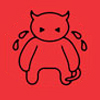- Mon Dec 15, 2008 9:18 pm
#287614
Forget the reason of why in all these discussions. All you need to understand is how to do it. Look at last diagram and ignore everything but the black and red lines. From a simplified modelling standpoint its two profiles that get revolved around a centerline. The black line is your closed volume that you would have as glass. The red is your OJ. There is a very tiny gap of .1mm or so between the glass that surrounds your OJ and the top of you OJ volume shown in red. This avoids the triangle overlapping issue in this area, and gives you accurate refraction. Hope that clears things up. No pun in intented.
Keep in mind the end result is an optical illusion because of refraction. The liquid does not really go all the way to the edges of the glass in your geometry so you dont have to worry about overlapping polygons if you model it the way he shows in the diagram.
Keep in mind the end result is an optical illusion because of refraction. The liquid does not really go all the way to the edges of the glass in your geometry so you dont have to worry about overlapping polygons if you model it the way he shows in the diagram.
Last edited by Eric Lagman on Mon Dec 15, 2008 9:24 pm, edited 2 times in total.






 - By Mark Bell
- By Mark Bell - By Edward Leibnitz
- By Edward Leibnitz